Continuing the series of post about the black and white pictures I made in 1980, with the pictures and the comments I posted more recently daily on Facebook.
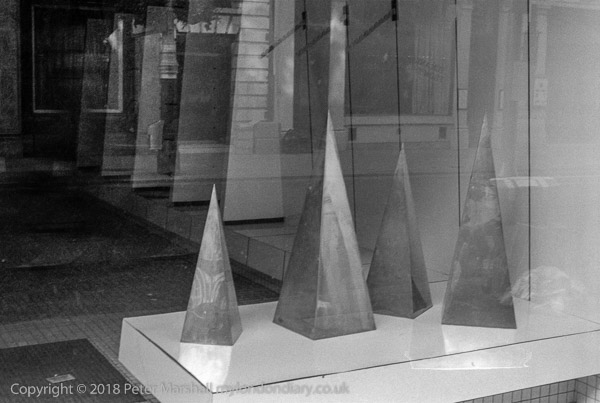
25f-15: pyramids, window, reflections
http://londonphotographs.co.uk/london/1980/25f-15.htm
I’m fairly sure this was somewhere in Fitzrovia, where a few frames earlier I had been outside the Northumberland Arms, at the corner of Charlotte St and Goodge St, recently renamed The Queen Charlotte, perhaps to avoid confusion with another Northumberland Arms on Tottenham Court Rd.
Why a shop window should have these four pyramids at its front is now certainly a matter of mystery at least to me, though presumably they were some kind of display stands. Apart from this what drew me to take four very similar frames was clearly the mix of reflections and interior which make the image difficult or impossible to decode.
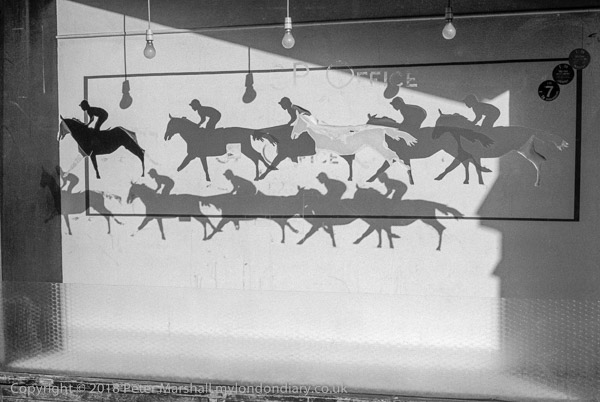
25f-23: horses, window, shadows,
http://londonphotographs.co.uk/london/1980/25f-23.htm
Another shop window in Fitzrovia which again poses something of a conundrum. It is clearly the window of a betting shop, which a fairly small distance between the glass and a screen behind, required then by law to prevent us seeing the inside of the betting shop. And the picture clearly has a mix of actual objects – the light bulbs and some peeling pictures of racing horses on the back of the window glass – and their shadows from late afternoon evening sun ( it was taken in July or August.)
The upper row of horses and riders are on the rear of the glass, with some peeling away more than others, and where they have peeled away slightly they now appear like shadows (though because they are closer to my camera are slightly large than the shadows), and the almost white riderless horse appears to have no shadow at all and nor does the lettering ‘P OFFICE’.

25f-31: houses, works
http://londonphotographs.co.uk/london/1980/25f-31.htm
The Farringdon Enamelling and Plating Works of A Smith were, along with Upholsterer R H Dillon on Clerkenwell Green as the window above the door helpfully informs us, and another business with a name beginning with ‘EN ‘and ending ‘P…..R’ has its ‘Works at Rear’.
Attracted doubtless both by the signage and the peeling paint, emphasised by the glancing sun, I had already made two frames when this man in a dirty white coat and striped tie walked out.
This little section of the street can still be recognised, but has gone up considerably in the world. One of the windows has been converted to a door, the paint no longer peels and the signage has disappeared. The building at right has been replaced by a modern structure with giant glass windows, The door from which a man is emerging is now for the Hammond Cox Casting Agency, the next window has been converted into a door for the Provision Trade Benevolent Institution and others, while the door at left, then a typesetter, is now for the Royal Philharmonic Orchestra. The tree is still there.
Behind me as I took this picture were public conveniences, which may well have been the reason for my visit, but which have been long closed.
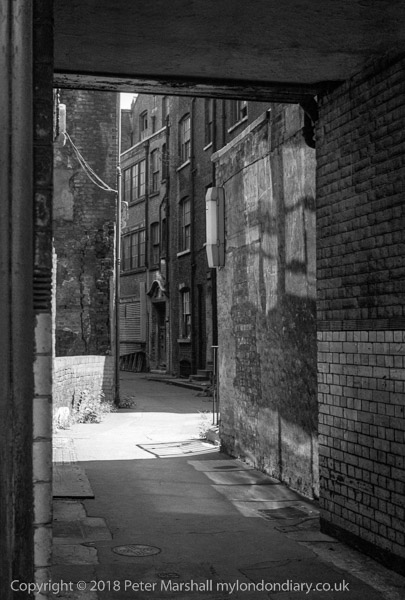
Cross Keys Square, Little Britain, London. 1980
25f-42: passage, houses
http://londonphotographs.co.uk/london/1980/25f-42.htm
Inside ‘Little Britain’, I think this is part of Cross Keys Square, and shows some clearly fairly elderly buildings, one of which, its windows now covered with corrugated iron, had previously been a Hairdressing Salon.
Much of the area was derelict when I took this picture and parts were inaccessible, with demolition or building work being carried out. The reflections on the brickwork at left interested me, and part of one of them rather looks like a shield or coat of arms, not dissimilar to the City of London’s which were on the light fittings.
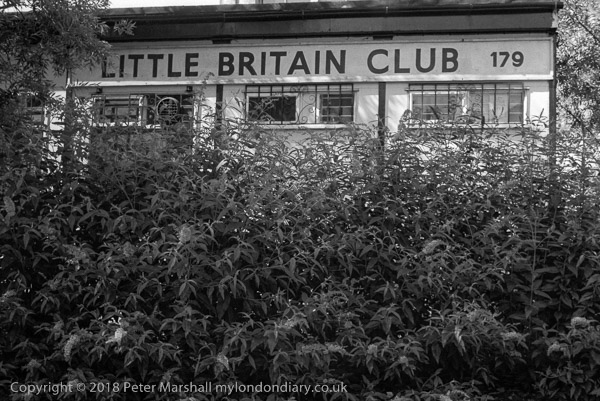
25f-53: club, waste ground
http://londonphotographs.co.uk/london/1980/25f-53.htm
Somewhere in the middle of ‘Little Britain’ was this club, and a patch of really overgrown waste ground, either formed by wartime bombing or later demolition.
Little Britain a century earlier had been famous for its ‘The Roaring Lads of Little Britain.’ who held weekly sessions at a pub “bearing for insignia a resplendent half-moon, with a most seductive bunch of grapes” run since “time immemorial” by the Wagstaff family and whose current landlord member presided over its singing and story-telling, according to Washington Irving in 1886.
The street number, 179, is almost certainly for Aldersgate St, and this was one of the many addresses listed in the planning application for demolition in January 1982, which was I think approved the following year:
“Demolition of all properties listed below, per dwg. ME/1: 11, 12, 13, 15, 16 Bartholowmew Close, 1 & 2, 7, 8, 4 & 11, 5 & 10, 6 & 9 Albion Buildings, 179 Aldersgate Street, *3 Little Montague Court, 1,2,3, Westmoreland Buildings, 4 Little Britain, 14, 15 Albion Buildings, 2a, 3, 4 Cox’s Court, 2, 2a, 3, Cross Key Square, Crown Buildings, Cox’s Court. The Garage on site of 21 Albion Buildings, 20, 21, 22, 23, 24, Little Britain, part of pedestrian walkway link to Rotunda * also 2 Little Montague Court.”
I think it was on a part of the site now occupied by London House, 172 Aldersgate St. These flats, “high-standard, fully serviced accommodation in London for the international business traveller”, have beside the entrance plaques stating it was the former site of London House. This was built for Henry Pierrepont, 1st Marquess of Dorchester (also the 2nd Earl of Kingston-upon-Hull) 1606-80, apparently a thoroughly unpleasant character, and after 1660 became the home of the Bishops of London.
After the bishops moved out it was let out to various tenants before briefly becoming in 1750–1751 the ‘City of London Lying-in Hospital for married women and sick and lame Outpatients’; it burnt down in the 1760s.
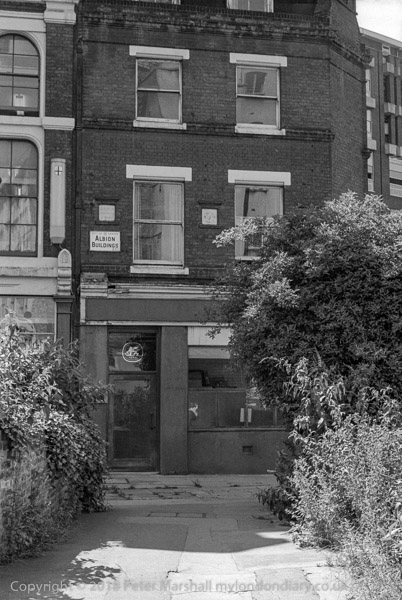
25f-54: shop, waste ground
http://londonphotographs.co.uk/london/1980/25f-54.htm
Also a part of ‘Little Britain ‘ was Albion Buildings, dating according to a stone in its frontage from 1766 (a second stone to the right is unreadable.) The sign above the door, which shows a stylized animal, a winged lion, with one of its front paws on what I think is an open book, is dated 1903. It perhaps reflects the time when this area was still the centre of the London publishing and secondhand book trade, which had been here since at least the 17th century. Pepys records a visit to Duck Lane (as Little Britain was then called) where he “kissed bookseller’s wife and bought Legend“. As well as going there to see the bookseller’s wife he is also recorded as buying several other books.
Albion Buildings (according to Webb – see comment below) were built in 1764 on the site of a 16th century house and gardens. In 1628 they were occupied by the Earl of Westmoreland and known as Westmorland Buildings, getting their name later from the Albion Tavern. Previous to 1764 the passage they are on was called Porridge Pot Alley.
The building on the left edge still has a fluorescent light on and appears to be still in use.
There is a very detailed account of the buildings and history of the area in E A Webb, ‘The parish: The close precinct and glebe houses‘, in The Records of St. Bartholomew’s Priory and St. Bartholomew the Great, West Smithfield: Volume 2 (Oxford, 1921), pp. 213-231 on British History Online. The map at the National Library of Scotland collection from 1896 is useful in understanding the layout of the area, though much had changed by 1980.
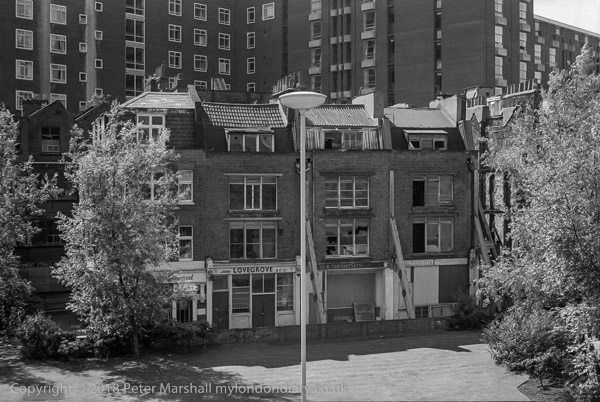
25f-62: shop, waste ground
http://londonphotographs.co.uk/london/1980/25f-62.htm
This small row of shops and businesses were I think empty – some clearly so, when I made this picture, I think from the elevated walkway along the side of the Barbican estate.
At left was a button maker ‘H R C….’ on the first floor and ‘Ernest Stark’ on the ground, then a business whose name is obscured by a three. At 6 was John Lovegrove & Co Ltd, then H R Thompson (with an unlikely ‘To Let’ sign) and ‘Basinghall Elect…’ presumably Electrics or Electrical… I have been unable to find any information about any of these.
All photographs on this and my other sites, unless otherwise stated, are taken by and copyright of Peter Marshall, and are available for reproduction or can be bought as prints.
There are no adverts on this site and it receives no sponsorship, and I like to keep it that way. But it does take a considerable amount of my time and thought, and if you enjoy reading it, please share on social media.
And small donations via Paypal – perhaps the cost of a beer – would be appreciated.